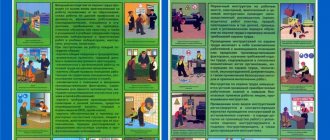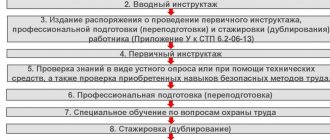According to the Labor Code of the Russian Federation, every employer is obliged to train a trainee or future employee in all standards of behavior in the organization in order to ensure safety in the workplace.
Before starting work at the enterprise, the future employee gets acquainted with various documentation related to labor protection. Based on the results, a sheet of familiarization with the labor protection instructions is filled out.
High-risk profession
What kind of document is this?
The work safety instruction sheet is a kind of form in the form of a table. It contains several standard information about the worker who has read the instructions. The document must be kept with each instruction and attached to the last page.
There is also a familiarization log, it contains information about occupational safety and health. The difference between the above documents is the scale. The journal contains all the instructions, but the sheet is for only one.
Note! When employed in an organization, each employee needs to know local regulations and his obligations.
All information can be found in the job description, and then you should read, remember it and sign it.
Norms of the Labor Code of the Russian Federation
Unfortunately, the labor legislation of the Russian Federation does not contain explanations on the use of one of the most important documents, such as a job description. Indeed, within the framework of Article 57 of the Labor Code of the Russian Federation, the range of responsibilities can now be fixed in the cooperation agreement.
However, many employers, remembering Soviet times, still draw up instructions, using them as an annex to the contract, thus giving them legal force.
By the way, on the basis of Letter of Rostrud dated 08/09/2007 N 3042-6-0, a job description can also be issued as an independent document, the procedure for familiarization with which is determined by the company.
It is worth noting that despite the fact that the creation of an DI is not mandatory and, accordingly, no sanctions will follow for its absence, negative consequences are possible.
In particular:
- misunderstanding of the parties about the limits of their powers;
- making decisions that violate the rights of an employee, taking into account that he may not know a detailed list of his responsibilities without DI;
- the possibility of legal proceedings due to refusal of employment on the basis of lack of appropriate qualifications, which, by the way, are specified in the instructions.
That is, through the job description, both the worker and the employer will protect themselves not only from interpersonal problems, but also from failure to complete the required amount of work, which will be enshrined in the DI, not to mention other aspects of future cooperation.
How to properly format a job description? Details are in the article. The form for an order to change job descriptions is here.
Why is it necessary to familiarize an employee with local regulations?
Occupational safety checklist
According to current rules, company management must familiarize employees with local regulations. It is the provisions of local documents that regulate the relationship between the parties in terms of labor relations and establish the rules that the administration and employees of the enterprise must follow.
All employees of the organization should read and remember their rights and responsibilities; only after familiarizing themselves with them can you demand something from people. That is, it is impossible to hold a person accountable for violations of labor discipline if he violated a rule that he did not know (or if it was not documented).
Why confirm familiarization with a signature?
The employee’s signature indicates that he understands the duties assigned to him and agrees to perform them. It is recommended that the employee be provided with a copy of the document to refer to the text as needed. In the event of a dispute regarding the content and quality of work, the list of job responsibilities is the main evidence; both the employer and the employee have the right to appeal to it.
ConsultantPlus experts examined whether the employer is obliged to draw up job descriptions for each employee separately or whether he has the right to draw up one instruction for the corresponding position. Use these instructions for free.
How an employee can be familiarized: sheet and familiarization log
Unscheduled briefing on labor protection: when is it carried out?
There are only two effective ways to familiarize staff with local regulations:
- Magazine. After the briefing, a special journal indicates the numbers of instructions with which a specific employee was familiarized.
Familiarization magazine
- Sheet. Forms are printed with all the necessary information and then given to the employee for registration and signature.
The employee must sign after the employer has reviewed the special assessment of working conditions during induction training.
Important! Some enterprises use one of the above options for familiarizing themselves with the instructions, but it is recommended to use both at once to avoid problems with the GIT.
The essence and role of the job description
Job descriptions of employees are not included in the package of mandatory local documents of the enterprise.
However, very often in employment contracts you can find the wording “according to the job description,” which means that most organizations still prefer to develop these documents. A job description is convenient: there is no need to list the employee’s functionality (often quite voluminous) directly in the employment contract; it is enough to make a reference to a separate instruction, which is a kind of annex to it.
The job description is drawn up and approved very simply: a set of functions, rights, powers and working conditions is formed for each specific position.
Usually a legal adviser, the head of a structural unit and a human resources specialist work on the document - this connection allows you to take into account all the nuances of the internal production process and the subtleties of the law.
After the job description is written, it is submitted for signature to the director of the company, who then puts it into effect by a separate order.
Each employee must familiarize himself with the job description that concerns him personally against signature.
At what stage do you read the instructions?
Often, to begin with, an introductory briefing is carried out, and then the employee is presented with a sheet. This must occur before he officially begins his work duties.
Labor safety induction program
Also, along with the basic training program at the workplace, the employee is presented with hazard and risk cards (HRC), IOT by profession, and with them special instructions regulating work.
Important! Employers should ask the question: “How to familiarize a new employee with the SOUT card?”, and pay more attention to this document.
The special assessment card for working conditions should record hazardous factors in the workplace, if any. A new worker is familiarized with it during induction training.
Types of labor safety briefings
The types of briefings, the procedure and requirements for organizing them by the employer are established by Resolution of the Ministry of Labor of the Russian Federation and the Ministry of Education of the Russian Federation dated January 13, 2003 N 1/29 “On approval of the Procedure for training in labor protection and testing knowledge of labor protection requirements for employees of organizations.”
Resolution 1/29 defines five types of briefings on labor protection: introductory, primary, repeated, unscheduled and targeted. Let's look at each type of instruction in more detail.
Introductory training on labor protection is carried out with all employees of the organization, without exception, upon hiring.
At its core, the introductory briefing is a story about what safety requirements must be observed while on the territory of the organization as a whole.
Introductory training is carried out according to a program approved by the employer, developed on the basis of regulations governing labor safety issues, taking into account the specifics of the organization's activities.
Conducting introductory training on labor protection is mandatory for absolutely all employees.
Introductory briefing, as a rule, is carried out by a specialist (engineer) in labor protection, or, in the absence of one (in organizations with a staff of less than 50 people), responsibility for carrying out this procedure is assigned to another official by order of the head of the organization. In small organizations, the responsibility for conducting induction training is most often assigned to the director.
The following types of briefings fall into the category of briefings that are given to an employee directly at his workplace. The carrying out of these briefings is assigned by order to the immediate supervisor of the work (head of the site, head of the unit, head of the department, etc.).
Initial briefing on labor protection - is carried out after the introductory briefing to all employees of the organization upon hiring, but before they begin their job duties.
Conducting initial training includes familiarizing the employee with existing dangerous or harmful production factors, studying the labor protection requirements contained in the organization’s local regulations, labor safety instructions, technical and operational documentation, as well as the use of safe methods and techniques for performing work.
Instruction is carried out according to approved programs developed separately for each position/profession and types of work. The initial training program is developed by the immediate supervisor of the work with the methodological support of a labor protection specialist.
Initial training can be carried out either individually with each employee or with a group of people who service the same type of equipment within a common workplace.
The employer may exempt from initial training employees whose duties are not related to the use, operation, maintenance, testing, adjustment and repair of equipment, the use of electrified or other mechanized hand tools, the storage and use of raw materials. To do this, the organization must approve a list of positions and professions of employees exempt from undergoing on-the-job training.
Repeated instruction on labor protection is carried out in order to consolidate the knowledge acquired by the employee on labor protection, at least once every 6 months.
Repeated training on labor protection is carried out with the same employees who have already undergone initial training, according to the same programs and instructions as the initial training in the workplace.
During repeated briefing, the employee is reminded of the labor protection rules for the given specialty and workplace.
Recommendation: in order not to be confused about the frequency of repeated briefings, you should set specific dates for it by order of the organization, for example: from January 10 to January 20 and from July 10 to July 20.
When establishing the frequency of repeated briefings, it should be taken into account that some industry rules on labor protection require repeated briefings to be carried out at least once every 3 months.
As a rule, these requirements apply to work associated with increased danger.
Unscheduled safety briefings are provided to employees in order to inform them about important changes that may affect their work due to:
- the occurrence of an emergency or a situation that poses a threat to safety;
- launch of new equipment;
- resuming the work process after a long period of inactivity;
- updates of regulations.
Also, unscheduled training on labor protection can be carried out at the request of supervisory authorities.
Unscheduled briefings have no set deadlines or frequency. The manager can assign it to individuals, departments and all personnel as a whole.
Unscheduled training should be carried out using either ready-made programs that are developed and approved by the organization, or labor protection instructions for a specific workplace/type of work. If an unscheduled briefing concerns changes in legislation, the texts of these documents must be used.
If at the time of repeated or unscheduled briefing the employee is absent from work (vacation, sick leave, business trip), he is instructed individually on the day he returns to work.
Targeted training on labor protection is carried out with employees when:
- performing one-time work not related to direct job responsibilities (cleaning work, loading and unloading work, etc.);
- performing work related to eliminating the consequences of accidents, natural disasters and catastrophes;
- carrying out work for which a permit is issued;
- conducting excursions and public events in the organization.
Targeted briefing, like unscheduled briefing, does not have established deadlines or frequency.
Targeted briefing programs do not have a clear structure and list of issues that need to be addressed. They are developed taking into account the profession or type of work performed by the employee on the basis of safety requirements set out in regulations on labor protection and operational documentation of equipment manufacturers.
How to design a sheet
From the sample sheet presented below, you can understand that it is not at all difficult to design. It is worth mentioning that the document looks like a small table with the necessary data. Filling out the sheet will not be difficult and will not take much time, because you only need a small range of information about the employee. The following columns are required in the table for familiarization with local acts:
- instruction number;
- worker's full name;
- the position he holds;
- the date when the person was familiarized with the document;
- signature.
The journal has a different type of table that contains more information.
Below is a sample sheet for familiarizing yourself with the labor safety instructions.
Reference list
Nuances
How to find out if an employee is familiar with the document?
The very fact of familiarization consists not only in reading the job description, but also in affixing a signature and date.
Accordingly, in order to find out whether the employee was properly familiarized with the specified document, it is enough to check whether its signature is in a magazine or sheet, and in a number of the cases described above, on the instructions themselves.
Read our article about making changes to the job description. How to register additional agreements to an employment contract? See here.
What ink should an employer use to fill out a sick leave certificate? Find out here.
Is it possible to register for several employees at once?
Of course, it is mandatory for the company's employees to familiarize themselves with the instructions against signature, but their responsibilities will be different, which predetermines not only different documents, but also several sheets.
Although, if the familiarization is recorded using a journal, the signature of all employees will be present in one document - the familiarization log.
How to do it correctly when translating?
As a rule, a transfer involves a change of position, the responsibilities of which differ significantly from previous assignments.
That is why, if a worker moves to another vacancy, he is given a new instruction for review, which he not only studies in detail, but also signs in a magazine or on a special sheet.
How much time is given to the employee to study the document?
The law does not provide for a specific period for familiarization with the job description, and, nevertheless, in most companies the specified process takes only a few hours.
After all, in order to read only three or four sheets, and also make a final decision, no more is required.
It is worth noting that the instructions are always published in several copies, one of which is given to the employee so that he has information not only about the range of his duties, but also the limits of his powers, not to mention his rights.
What should a personnel officer do if a refusal is received from an employee?
In most cases, the job description contains a list of responsibilities that correspond to the job function of the position, given that the DI is initially created on the basis of qualification requirements.
Moreover, if the employer changes some of the responsibilities that are no longer consistent with the employee’s job purpose, his consent is required, since changes will also have to be made to the cooperation agreement in the manner prescribed by Article 72 of the Labor Code of the Russian Federation.
If no fundamental changes are expected, but the worker still does not agree with the innovation, there are only two options left:
- negotiate amicably;
- work as usual on the basis of the job description in its original form.
Attention!
- Due to frequent changes in legislation, information sometimes becomes outdated faster than we can update it on the website.
- All cases are very individual and depend on many factors. Basic information does not guarantee a solution to your specific problems.
That's why FREE expert consultants work for you around the clock!
- via the form (below), or via online chat
- Call the hotline:
- 8 (800) 700 95 53
APPLICATIONS AND CALLS ARE ACCEPTED 24/7 and 7 days a week.
Job Descriptions
Why do you need an employee signature?
First of all, the signature is placed so that the employee understands that he himself is responsible for non-compliance with labor safety instructions after reading them. It is a kind of guarantee that a person has read all the necessary information, remembered the rules and will not deliberately endanger his life or injure himself by violating the established order.
There are often cases where an employee, not following company instructions, was injured and could then sue for monetary compensation. In such moments, the signature on the familiarization sheet plays a big role. If a person knew all the nuances, but was still injured, then it will be problematic to obtain compensation after such an injury.
Instructions for fire safety at an enterprise
The main points of the instructional document should include norms and rules, as well as a list of officials responsible for the fire safety condition and maintenance of the organization’s facilities.
This list should include both the main managers of the company and employees heading structural divisions. The list of actions carried out by the manager includes the general management of activities aimed at combating the occurrence of a fire. During working hours, he also alerts special services about an emergency.
The period for reviewing fire safety regulations is five years. In some cases, the form is updated earlier than the specified deadline. The basis for the revision may be a change in current legislation, a change in the features of production, or instructions from control authorities.
How long and how to store the form
Job descriptions relate to personnel documentation and, as a rule, are stored in the organization’s archives for at least 75 years.
However, based on government regulations, the validity period of the instruction is 5 years for those professions where there is no increased danger to human life. If the work involves a risk of injury, then this occupational safety document is valid for only 3 years.
Note! As time passes, the instructions are reviewed, changed and re-agreed with the worker.
If work with increased risk is carried out from time to time (not systematically), then it must be carried out according to a work permit regulated in a special journal. It is also indicated that occupational safety training will be carried out when issuing a work permit. Such instruction should be carried out at certain intervals: at least 4 times a year, if the work involves increased danger; or 2 times a year, if not connected.
GOST standards for office work 2021
The requirements for the preparation of official documents at present are formulated in the national standard of the Russian Federation GOST R 7.0.97-2016 “System of standards for information, library and publishing. Organizational and administrative documentation. Documentation requirements." It replaced the state standard of the Russian Federation GOST R 6.30-2003.
In our opinion, it is useful to start getting acquainted with GOST for office work by studying the terminology, which is described in detail by another national standard - GOST R 7.0.8-2013 (GOST office work and archiving), since this knowledge will help to correctly understand and use professional vocabulary.
It defines the concepts used in the article:
- Document is information recorded on a medium with details that allow it to be identified.
- Document execution - putting the necessary details on the document.
- Document attribute is an element of document design.
GOST R 7.0.8-2013
Is it possible to fire an employee for refusing to sign a sheet?
As a rule, a sheet with instructions on labor protection is presented to employees before they begin to fulfill their obligations.
However, if a person does not agree to sign this document, then the company has the right not to provide him with the opportunity to work. An employee must know the general regulations on labor protection in the organization in order to avoid dangerous situations in the workplace. The signature on the sheet officially confirms that the person has read the instructions and is aware of the consequences.
Stages of work
Work with documents in an organization is divided into stages.
- reception and primary processing;
- preliminary review by the clerk;
- registration;
- consideration by the management of the organization and direction for execution;
- processing, execution, preparation of responses;
- execution control.
- development, design;
- registration;
- dispatch.
- development, design;
- registration;
- processing, execution, preparation of responses;
- execution control.
- accounting and analysis of document flow volumes;
- storage.
The speed at which the stages are completed directly depends on the correctness of the paperwork, as well as on the document flow standards approved by the organization. A sample regulation on document flow in an organization (2019) can be downloaded below.
Sample familiarization sheet and signature in the magazine
In the event that a company issues an order that is directly related to or concerns employees, all employees must familiarize themselves with it and sign it. This is a legal requirement obliging company managers to familiarize people with all local regulatory documents of the company.
An order is an order of the employer, which is documented in writing and contains all the information about the new decision. Orders can only be issued by the director of the organization.
Important! Orders must in no case violate the civil and labor rights of workers.
Folders in hands
Management is obliged to inform employees about labor safety in the workplace; this is extremely necessary so as not to endanger their lives and health. There are many works where familiarity with this document plays a big role in a person’s future life. Firefighters, welders, technicians and other life-threatening professions require a serious attitude towards occupational safety instructions, since without familiarization with it, human safety may be at risk.
Structure of production instructions
Let us therefore study the structure in which a typical production instruction can be presented. The document in question most often consists of the following key sections:
- "General provisions".
- "Qualification requirements."
- "Production functions".
- "Responsibilities".
- "Rights".
- "Responsibility".
In some cases, the production instructions are supplemented with other sections - for example, regulating the procedure for rewarding an employee for outstanding achievements in work.
The specified structure of the document, in general, is applicable to the job description. The main delimiting criterion between the corresponding types of documents, as we noted above, is the scope of application.
The procedure for developing production instructions is usually approved by local regulations of the employer company, since such sources of law are not accepted at the official level in the Russian Federation. Let's study the procedure for developing the source in question in more detail.











